2009年江南大学605微生物学(A)考研真题【圣才出品】
2009年微生物学模拟试卷(A)参考答案

2009年微生物学模拟试卷(A)参考答案)一、填空题(每空0.5分,共18分)1.显微镜测微尺、微米、直径、长度和宽度、相对、真正2.芽殖、裂殖、产生无性孢子3.葡聚糖、甘露聚糖、蛋白质、几丁质4.光能无机自养型、光能有机异养型、化能无机自养型、化能有机异养型5.扩散、促进扩散、主动运输、膜泡运输6.乙醛、丙酮酸7.恒浊法、恒化法8.Griffith的转化实验、 Avery等的转化实验、T2 phage的感染实验9.大肠杆菌、枯草芽孢杆菌10.根霉属、酵母菌属11.分辨率、数值孔径值、0.18微米、1000~1500倍二、判断题(对打“√”,错打“×”,每小题1分,共10分)1.√,2.×,3. √,4. ×,5. √,6. ×,7. √,8. √,9. √, 10. ×三、单项选择题(每小题1分,共10分)1. C ,2.A,3. C,4. B ,5. B ,6. A ,7. D,8. A ,9. A , 10. B四、简答题(每小题5分,共30分)1.(1)个体极小;(2)没有细胞结构,大多数病毒是由蛋白质外壳包围着核酸,而且只含单一DNA或RNA;(3)严格的活细胞寄生;(4)病毒核酸使病毒能利用寄主细胞进行复制;(5)具有侵染力;(6)具抵抗力病毒对抗生素不敏感,而干扰素却能阻止病毒的复制。
2.(1)非对应性;(2)稀有性;(3)规律性;(4)独立性;(5)遗传和回复性;(6)可诱变性。
3.先将待分离的材料用无菌水作一系列的稀释(1:10、1:100、1:1000、1:10000…)(,然后分别取不同的稀释液少许,与已熔化并冷却至50℃左右的琼脂培养基混合,摇匀后,倾入灭过菌的培养皿中,待琼脂凝固后制成可能含菌的琼脂平板,保留培养一定时间即可出现菌落。
如果稀得当,在平板表面或琼脂培养基中就可出现分散的单个菌落,这个菌落可能就是有一个细菌细胞繁殖形成,随后挑起该单个菌落,或重复以上操作数次,便可得到纯培养。
2009年江南发酵考研微生物试题及答案
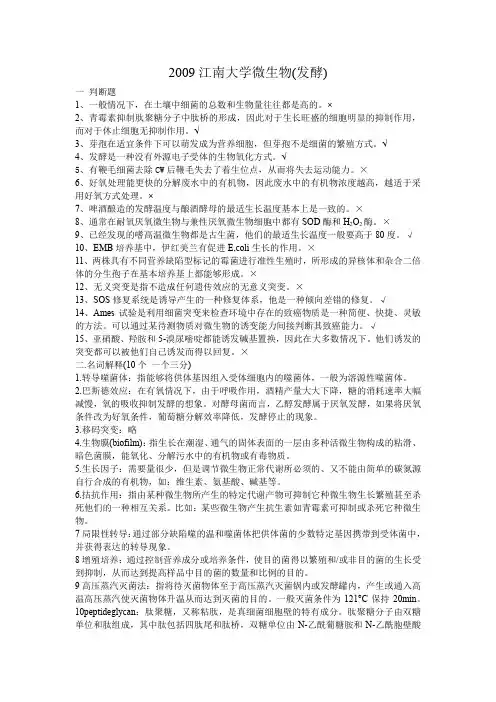
2009江南大学微生物(发酵)一判断题1、一般情况下,在土壤中细菌的总数和生物量往往都是高的。
×2、青霉素抑制肽聚糖分子中肽桥的形成,因此对于生长旺盛的细胞明显的抑制作用,而对于休止细胞无抑制作用。
√3、芽孢在适宜条件下可以萌发成为营养细胞,但芽孢不是细菌的繁殖方式。
√4、发酵是一种没有外源电子受体的生物氧化方式。
√5、有鞭毛细菌去除CW后鞭毛失去了着生位点,从而将失去运动能力。
×6、好氧处理能更快的分解废水中的有机物,因此废水中的有机物浓度越高,越适于采用好氧方式处理。
×7、啤酒酿造的发酵温度与酿酒酵母的最适生长温度基本上是一致的。
×8、通常在耐氧厌氧微生物与兼性厌氧微生物细胞中都有SOD酶和H2O2酶。
×9、已经发现的嗜高温微生物都是古生菌,他们的最适生长温度一般要高于80度。
√10、EMB培养基中,伊红美兰有促进E,coli生长的作用。
×11、两株具有不同营养缺陷型标记的霉菌进行准性生殖时,所形成的异核体和杂合二倍体的分生孢子在基本培养基上都能够形成。
×12、无义突变是指不造成任何遗传效应的无意义突变。
×13、SOS修复系统是诱导产生的一种修复体系,他是一种倾向差错的修复。
√14、Ames试验是利用细菌突变来检查环境中存在的致癌物质是一种简便、快捷、灵敏的方法。
可以通过某待测物质对微生物的诱变能力间接判断其致癌能力。
√15、亚硝酸、羟胺和5-溴尿嘧啶都能诱发碱基置换,因此在大多数情况下。
他们诱发的突变都可以被他们自己诱发而得以回复。
×二.名词解释(10个一个三分)1.转导噬菌体:指能够将供体基因组入受体细胞内的噬菌体,一般为溶源性噬菌体。
2.巴斯德效应:在有氧情况下,由于呼吸作用,酒精产量大大下降,糖的消耗速率大幅减慢,氧的吸收抑制发酵的想象。
对酵母菌而言,乙醇发酵属于厌氧发酵,如果将厌氧条件改为好氧条件,葡萄糖分解效率降低,发酵停止的现象。
2009~2012年江南大学生物化学考研真题(回忆版)【圣才出品】
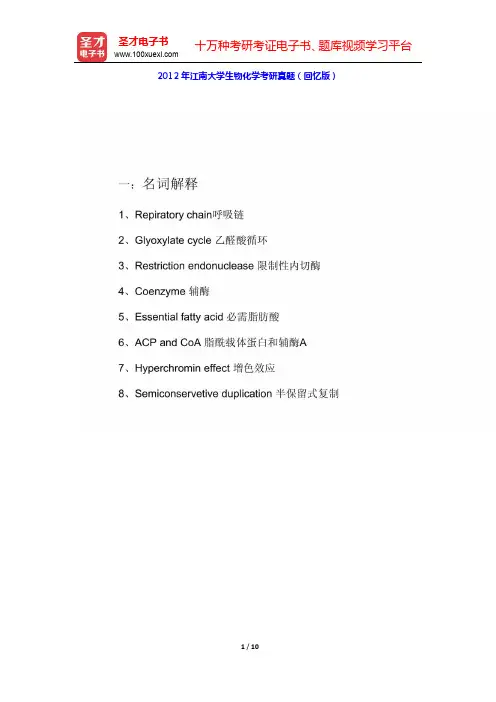
2012年江南大学生物化学考研真题(回忆版)2011年江南大学生物化学考研真题(回忆版)一、名词解释:40分1.DNA melting temperature2.subunit3.promoter4.leading chain5 oligoenzyme activation6.urea cycle二、判断正误并改正(20分)1.所有的B族维生素都能作为辅基参与生物反应2.肉毒碱能抑制脂肪的氧化3.1g蛋白经电泳得10mg纯蛋白,则比活力提高100倍4.单纯逆反应三、简答题(40分)1.写出蔗糖、麦芽糖和乳糖的组成结构以及主要反映,并写出鉴别上述糖的方法。
2.写出别构效应的原理。
3.写出吡哆醇和泛酸的活性形式以及其生物反应中的作用。
4.为什么凯氏定氮法只能粗略检测蛋白质含量?请写出一种不增加设备的情况下就能排除杂氮的影响的方法?四、简答题(50分)1.请设计反映鉴别抑制剂是可逆抑制剂还是不可逆抑制剂,并写出可逆抑制剂三种情况的动力学特点。
(12)2.有一个脂肪由两个软脂酸和一个硬脂酸以及一个甘油组成,写出它在体内完全降解的反应过程(可用流程图表示)以及生成的ATP数。
(13)3.写出DNA以及三种RNA的二级结构在蛋白质合成的作用。
(12)4.写出酶的调控方式过程,并说明它的生物学意义。
(13)2010年江南大学生物化学考研真题(回忆版)一、名词解释1.Ultrafiltration2.Pentose phosphate pathway3.Chargaff principal4.Domain5.Reverse transcription6.Hyper chromic effect二、判断题1.别构酶总是寡聚酶。
2.肽链就是亚基。
3.单糖α型和β型是对映体。
4.某一基因发生了点突变,则必然导致其编码的蛋白质的氨基酸序列改变! {7 Q(5.糖酵解是不依赖氧气的代谢,因此有无氧气都不会影响糖酵解途径。
2009年全国硕士研究生入学统一考试真题加答案
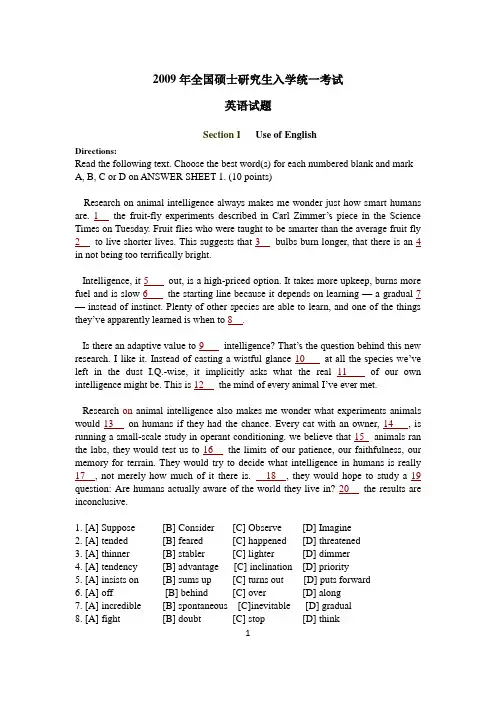
2009年全国硕士研究生入学统一考试英语试题Section I Use of EnglishDirections:Read the following text. Choose the best word(s) for each numbered blank and mark A, B, C or D on ANSWER SHEET 1. (10 points)Research on animal intelligence always makes me wonder just how smart humans are.1 the fruit-fly experiments described in Carl Zimmer‘s piece in the Science Times on Tuesday. Fruit flies who were taught to be smarter than the average fruit fly 2 to live shorter lives. This suggests that 3 bulbs burn longer, that there is an 4 in not being too terrifically bright.Intelligence, it 5 out, is a high-priced option. It takes more upkeep, burns more fuel and is slow 6 the starting line because it depends on learning — a gradual 7 — instead of instinct. Plenty of other species are able to learn, and one of the things they‘ve apparently learned is when to 8 .Is there an adaptive value to 9 intelligence? That‘s the question behind this new research. I like it. Instead of casting a wistful glance 10 at all the species we‘ve left in the dust I.Q.-wise, it implicitly asks what the real11 of our own intelligence might be. This is 12 the mind of every animal I‘ve ever met.Research on animal intelligence also makes me wonder what experiments animals would 13 on humans if they had the chance. Every cat with an owner, 14 , is running a small-scale study in operant conditioning. we believe that 15 animals ran the labs, they would test us to 16 the limits of our patience, our faithfulness, our memory for terrain. They would try to decide what intelligence in humans is really 17 , not merely how much of it there is. 18 , they would hope to study a 19 question: Are humans actually aware of the world they live in? 20 the results are inconclusive.1. [A] Suppose [B] Consider [C] Observe [D] Imagine2. [A] tended [B] feared [C] happened [D] threatened3. [A] thinner [B] stabler [C] lighter [D] dimmer4. [A] tendency [B] advantage [C] inclination [D] priority5. [A] insists on [B] sums up [C] turns out [D] puts forward6. [A] off [B] behind [C] over [D] along7. [A] incredible [B] spontaneous [C]inevitable [D] gradual8. [A] fight [B] doubt [C] stop [D] think19. [A] invisible [B] limited [C] indefinite [D] different10. [A] upward [B] forward [C] afterward [D] backward11. [A] features [B] influences [C] results [D] costs12. [A] outside [B] on [C] by [D] across13. [A] deliver [B] carry [C] perform [D] apply14. [A] by chance [B] in contrast [C] as usual [D] for instance15. [A] if [B] unless [C] as [D] lest16. [A] moderate [B] overcome [C] determine [D] reach17. [A] at [B] for [C] after [D] with18. [A] Above all [B] After all [C] However [D] Otherwise19. [A] fundamental [B] comprehensive [C] equivalent [D] hostile20. [A] By accident [B] In time [C] So far [D] Better stillSection II Reading ComprehensionPart ADirections:Read the following four texts. Answer the questions below each text by choosing A, B, C or D. Mark your answers on ANSWER SHEET 1. (40 points)Text1Habits are a funny thing. We reach for them mindlessly, setting our brains on auto-pilot and relaxing into the unconscious comfort of familiar routine. ―Not choice, but habit rules the unreflecting herd,‖ William Wordsworth said in the 19th century. In the ever-changing 21st century, even the word ―habit‖ carries a ne gative connotation.So it seems antithetical to talk about habits in the same context as creativity and innovation. But brain researchers have discovered that when we consciously develop new habits, we create parallel synaptic paths, and even entirely new brain cells, that can jump our trains of thought onto new, innovative tracks.But don‘t bother trying to kill off old habits; once those ruts of procedure are worn into the hippocampus, they‘re there to stay. Instead, the new habits we deliberately ingrain into ourselves create parallel pathways that can bypass those old roads.―The first thing needed for innovation is a fascination with wonder,‖ says Dawna Markova, author of ―The Open Mind‖ and an executive change consultant for Professional Thinking Part ners. ―But we are taught instead to ‗decide,‘ just as our president calls himself ‗the Decider.‘‖ She adds, however, that ―to decide is to kill off all possibilities but one. A good innovational thinker is always exploring the many other possibilities.‖A ll of us work through problems in ways of which we‘re unaware, she says. Researchers in the late 1960 covered that humans are born with the capacity to2approach challenges in four primary ways: analytically, procedurally, relationally (or collaboratively) and innovatively. At puberty, however, the brain shuts down half of that capacity, preserving only those modes of thought that have seemed most valuable during the first decade or so of life.The current emphasis on standardized testing highlights analysis and procedure, meaning that few of us inherently use our innovative and collaborative modes of thought. ―This breaks the major rule in the American belief system — that anyone can do anything,‖ explains M. J. Ryan, author of the 2006 book ―This Year I Will...‖ and Ms. Markova‘s business partner. ―That‘s a lie that we have perpetuated, and it fosters commonness. Knowing what you‘re good at and doing even more of it creates excellence.‖ This is where developing new habits comes in.21. The view of Wordsworth habit is claimed by beingA. casualB. familiarC. mechanicalD. changeable.22. The researchers have discovered that the formation of habit can beA. predictedB. regulatedC. tracedD. guided23.‖ ruts‖(in li ne one, paragraph 3) has closest meaning toA. tracksB. seriesC. characteristicsD. connections24. Ms. Markova‘s comments suggest that the practice of standard testing ? A, prevents new habits form being formedB, no longer emphasizes commonnessC, maintains the inherent American thinking modelD, complies with the American belief system25. Ryan most probably agree thatA. ideas are born of a relaxing mindB. innovativeness could be taughtC. decisiveness derives from fantastic ideasD. curiosity activates creative mindsText 2It is a wise father that knows his own child, but today a man can boost his paternal (fatherly) wisdom –or at least confirm that he‘s the kid‘s dad. All he needs to do is shell our $30 for paternity testing kit (PTK) at his local drugstore – and another $120 to get the results.More than 60,000 people have purchased the PTKs since they first become available without prescriptions last years, according to Doug Fog, chief operating officer of Identigene, which makes the over-the-counter kits. More than two dozen companies sell DNA tests Directly to the public , ranging in price from a few hundred dollars to more than $2500.3Among the most popular : paternity and kinship testing , which adopted children can use to find their biological relatives and latest rage a many passionate genealogists-and supports businesses that offer to search for a family‘s geographic roots .Most tests require collecting cells by webbing saliva in the mouth and sending it to the company for testing. All tests require a potential candidate with whom to compare DNA.But some observers are skeptical, ―There is a kind of false precision being hawked by people claiming they are doing ancestry testing,‖ says Trey Duster, a New York University sociologist. He notes that each individual has many ancestors-numbering in the hundreds just a few centuries back. Yet most ancestry testing only considers a single lineage, either the Y chromosome inherited through men in a father‘s line or mito chondrial DNA, which a passed down only from mothers. This DNA can reveal genetic information about only one or two ancestors, even though, for example, just three generations back people also have six other great-grandparents or, four generations back, 14 other great-great-grandparents.Critics also argue that commercial genetic testing is only as good as the reference collections to which a sample is compared. Databases used by some companies don‘t rely on data collected systematically but rather lump together information from different research projects. This means that a DNA database may differ depending on the company that processes the results. In addition, the computer programs a company uses to estimate relationships may be patented and not subject to peer review or outside evaluation.26.In paragraphs 1 and 2 , the text shows PTK‘s ___________.[A]easy availability[B]flexibility in pricing[C] successful promotion[D] popularity with households27. PTK is used to __________.[A]locate one‘s b irth place[B]promote genetic research[C] identify parent-child kinship[D] choose children for adoption28. Skeptical observers believe that ancestry testing fails to__________.[A]trace distant ancestors[B] rebuild reliable bloodlines[C] fully use genetic information[D] achieve the claimed accuracy29. In the last paragraph ,a problem commercial genetic testing faces is __________.4[A]disorganized data collection[B] overlapping database building30. An appropriate title for the text is most likely to be__________.[A]Fors and Againsts of DNA testing[B] DNA testing and It‘s problems[C]DNA testing outside the lab[D] lies behind DNA testingText 3The relationship between formal education and economic growth in poor countries is widely misunderstood by economists and politicians alike progress in both area is undoubtedly necessary for the social, political and intellectual development of these and all other societies; however, the conventional view that education should be one of the very highest priorities for promoting rapid economic development in poor countries is wrong. We are fortunate that is it, because new educational systems there and putting enough people through them to improve economic performance would require two or three generations. The findings of a research institution have consistently shown that workers in all countries can be trained on the job to achieve radical higher productivity and, as a result, radically higher standards of living.Ironically, the first evidence for this idea appeared in the United States. Not long ago, with the country entering a recessing and Japan at its pre-bubble peak. The U.S. workforce was derided as poorly educated and one of primary cause of the poor U.S. economic performance. Japan was, and remains, the global leader in automotive-assembly productivity. Yet the research revealed that the U.S. factories of Honda Nissan, and Toyota achieved about 95 percent of the productivity of their Japanese countere pants a result of the training that U.S. workers received on the job.More recently, while examing housing construction, the researchers discovered that illiterate, non-English- speaking Mexican workers in Houston, Texas, consistently met best-practice labor productivity standards despite the complexity of the building industry‘s work.What is the real relationship between education and economic development? We have to suspect that continuing economic growth promotes the development of education even when governments don‘t force it. After all, that‘s how education got started. When our ancestors were hunters and gatherers 10,000 years ago, they didn‘t have time to wonder much about anything besides finding food. Only when humanity began to get its food in a more productive way was there time for other things.As education improved, humanity‘s productivity potential, they could in turn afford more education. This increasingly high level of education is probably a necessary, but not a sufficient, condition for the complex political systems required by advanced5economic performance. Thus poor countries might not be able to escape their poverty traps without political changes that may be possible only with broader formal education. A lack of formal education, however, doesn‘t const rain the ability of the developing world‘s workforce to substantially improve productivity for the forested future. On the contrary, constraints on improving productivity explain why education isn‘t developing more quickly there than it is.31. The author holds in paragraph 1 that the important of education in poor countries ___________.[A] is subject groundless doubts[B] has fallen victim of bias[C] is conventional downgraded[D] has been overestimated32. It is stated in paragraph 1 that construction of a new education system __________.[A]challenges economists and politicians[B]takes efforts of generations[C] demands priority from the government[D] requires sufficient labor force33.A major difference between the Japanese and U.S workforces is that __________.[A] the Japanese workforce is better disciplined[B] the Japanese workforce is more productive[C]the U.S workforce has a better education[D] ]the U.S workforce is more organize34. The author quotes the example of our ancestors to show that education emerged __________.[A] when people had enough time[B] prior to better ways of finding food[C] when people on longer went hung[D] as a result of pressure on government35. According to the last paragraph , development of education __________.[A] results directly from competitive environments[B] does not depend on economic performance[C] follows improved productivity[D] cannot afford political changesText 4The most thoroughly studied in the history of the new world are the ministers and political leaders of seventeenth-century New England. According to the standard history of American philosophy, nowhere else in colonial America was ―So much6important attached to intellectual pursuits ‖ Accord ing to many books and articles, New England‘s leaders established the basic themes and preoccupations of an unfolding, dominant Puritan tradition in American intellectual life.To take this approach to the New Englanders normally mean to start with the Puritans‘ theological innovations and their distinctive ideas about the church-important subjects that we may not neglect. But in keeping with our examination of southern intellectual life, we may consider the original Puritans as carriers of European culture adjusting to New world circumstances. The New England colonies were the scenes of important episodes in the pursuit of widely understood ideals of civility and virtuosity.The early settlers of Massachusetts Bay included men of impressive education and influence in England. `Besides the ninety or so learned ministers who came to Massachusetts church in the decade after 1629,There were political leaders like John Winthrop, an educated gentleman, lawyer, and official of the Crown before he journeyed to Boston. There men wrote and published extensively, reaching both New World and Old World audiences, and giving New England an atmosphere of intellectual earnestness.We should not forget , however, that most New Englanders were less well educated. While few crafts men or farmers, let alone dependents and servants, left literary compositions to be analyzed, The in thinking often had a traditional superstitions quality. A tailor named John Dane, who emigrated in the late 1630s, left an account of his reasons for leaving England that is filled with signs. sexual confusion, economic frustrations , and religious hope-all name together in a decisive moment when he opened the Bible, told his father the first line he saw would settle his fate, and read th e magical words: ―come out from among them, touch no unclean thing , and I will be your God and you shall be my people.‖ One wonders what Dane thought of the careful sermons explaining the Bible that he heard in puritan churched.Mean while , many se ttles had slighter religious commitments than Dane‘s, as one clergyman learned in confronting folk along the coast who mocked that they had not come to the New world for religion . ―Our main end was to catch fish. ‖36. The author notes that in the seventeenth-century New England___________.[A] Puritan tradition dominated political life.[B] intellectual interests were encouraged.[C] Politics benefited much from intellectual endeavors.[D] intellectual pursuits enjoyed a liberal environment.37. It is suggested in paragraph 2 that New Englanders__________.[A] experienced a comparatively peaceful early history.[B] brought with them the culture of the Old World[C] paid little attention to southern intellectual life[D] were obsessed with religious innovations738. The early ministers and political leaders in Massachusetts Bay__________.[A] were famous in the New World for their writings[B] gained increasing importance in religious affairs[C] abandoned high positions before coming to the New World[D] created a new intellectual atmosphere in New England39. The story of John Dane shows that less well-educated New Englanders were often __________.[A] influenced by superstitions[B] troubled with religious beliefs[C] puzzled by church sermons[D] frustrated with family earnings40. The text suggests that early settlers in New England__________.[A] were mostly engaged in political activities[B] were motivated by an illusory prospect[C] came from different backgrounds.[D] left few formal records for later referencePart BDirections:Directions: In the following text, some sentences have been removed. For Questions (41-45), choose the most suitable one from the list A-G to fit into each of the numbered blank. There are two extra choices, which do not fit in any of the gaps. Mark your answers on ANSWER SHEET 1. (10 points)Coinciding with the groundbreaking theory of biological evolution proposed by British naturalist Charles Darwin in the 1860s, British social philosopher Herbert Spencer put forward his own theory of biological and cultural evolution. Spencer argued that all worldly phenomena, including human societies, changed over time, advancing toward perfection. 41.____________.American social scientist Lewis Henry Morgan introduced another theory of cultural evolution in the late 1800s. Morgan, along with Tylor, was one of the founders of modern anthropology. In his work, he attempted to show how all aspects of culture changed together in the evolution of societies.42._____________.In the early 1900s in North America, German-born American anthropologist Franz Boas developed a new theory of culture known as historical particularism. Historical particularism, which emphasized the uniqueness of all cultures, gave new direction to anthropology. 43._____________ .8Boas felt that the culture of any society must be understood as the result of a unique history and not as one of many cultures belonging to a broader evolutionary stage or type of culture. 44._______________.Historical particularism became a dominant approach to the study of culture in American anthropology, largely through the influence of many students of Boas. But a number of anthropologists in the early 1900s also rejected the particularist theory of culture in favor of diffusionism. Some attributed virtually every important cultural achievement to the inventions of a few, especially gifted peoples that, according to diffusionists, then spread to other cultures. 45.________________.Also in the early 1900s, French sociologist Émile Durkheim developed a theory of culture that would greatly influence anthropology. Durkheim proposed that religious beliefs functioned to reinforce social solidarity. An interest in the relationship between the function of society and culture—known as functionalism—became a major theme in European, and especially British, anthropology.[A] Other anthropologists believed that cultural innovations, such as inventions, had a single origin and passed from society to society. This theory was known as diffusionism.[B] In order to study particular cultures as completely as possible, Boas became skilled in linguistics, the study of languages, and in physical anthropology, the study of human biology and anatomy.[C] He argued that human evolution was characterized by a struggle he called the ―survival of the fittest,‖ in which weaker races and societies must eventu ally be replaced by stronger, more advanced races and societies.[D] They also focused on important rituals that appeared to preserve a people‘s social structure, such as initiation ceremonies that formally signify children‘s entrance into adulthood.[E] Thus, in his view, diverse aspects of culture, such as the structure of families, forms of marriage, categories of kinship, ownership of property, forms of government, technology, and systems of food production, all changed as societies evolved.[F]Supporters of the theory viewed as a collection of integrated parts that work together to keep a society functioning.[G] For example, British anthropologists Grafton Elliot Smith and W. J. Perry incorrectly suggested, on the basis of inadequate information, that farming, pottery9making, and metallurgy all originated in ancient Egypt and diffused throughout the world. In fact, all of these cultural developments occurred separately at different times in many parts of the world.Part CDirections:Read the following text carefully and then translate the underlined segments into Chinese. Your translation should be written carefully on ANSWER SHEET 2. (10 points)There is a marked difference between the education which every one gets from living with others, and the deliberate educating of the young. In the former case the education is incidental; it is natural and important, but it is not the express reason of the association.46It may be said that the measure of the worth of any social institution is its effect in enlarging and improving experience; but this effect is not a part of its original motive. Religious associations began, for example, in the desire to secure the favor of overruling powers and to ward off evil influences; family life in the desire to gratify appetites and secure family perpetuity; systematic labor, for the most part, because of enslavement to others, etc. 47Only gradually was the by-product of the institution noted, and only more gradually still was this effect considered as a directive factor in the conduct of the institution. Even today, in our industrial life, apart from certain values of industriousness and thrift, the intellectual and emotional reaction of the forms of human association under which the world's work is carried on receives little attention as compared with physical output.But in dealing with the young, the fact of association itself as an immediate human fact, gains in importance.48 While it is easy to ignore in our contact with them the effect of our acts upon their disposition, it is not so easy as in dealing with adults. The need of training is too evident; the pressure to accomplish a change in their attitude and habits is too urgent to leave these consequences wholly out of account. 49Since our chief business with them is to enable them to share in a common life we cannot help considering whether or no we are forming the powers which will secure this ability.If humanity has made some headway in realizing that the ultimate value of every institution is its distinctively human effect we may well believe that this lesson has been learned largely through dealings with the young.50 We are thus led to distinguish, within the broad educational process which we have been so far considering, a more formal kind of education -- that of direct tuition or schooling. In undeveloped social groups, we find very little formal teaching and training. These groups mainly rely for instilling needed dispositions into the young upon the same sort of association which keeps the adults loyal to their group.Section & Writing10Part A51. Directions:Restrictions on the use of plastic bags have not been so successful in some regions. ―White pollution ‖is still going on. Write a letter to the editor(s) of your local newspaper to1)give your opinions briefly and2)make two or three suggestionsYou should write about 100 words. Do not sign your own name at the end of the letter. Use "Li Ming" instead. You do not need to write the address.Part B52. Directions:In your essay, you should1) describe the drawing briefly,2) explain its intended meaning, and then3) give your comments.You should write neatly on ANSHWER SHEET 2. (20 points)11。
2009级攻读硕士学位研究生入学考试试题.doc
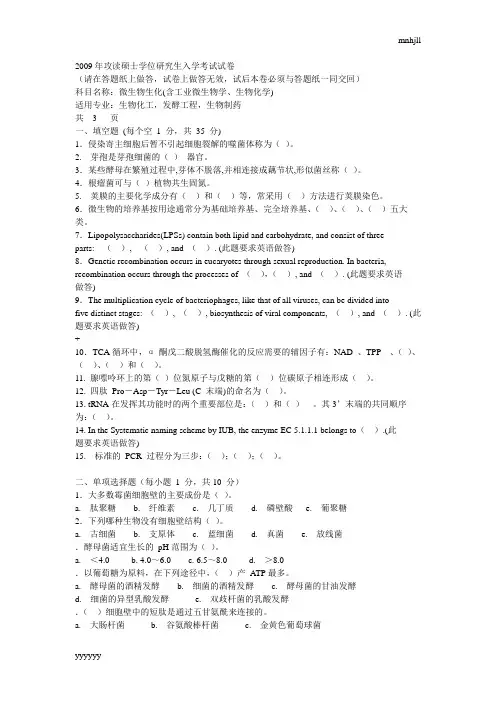
2009年攻读硕士学位研究生入学考试试卷(请在答题纸上做答,试卷上做答无效,试后本卷必须与答题纸一同交回)科目名称:微生物生化(含工业微生物学、生物化学)适用专业:生物化工,发酵工程,生物制药共 3 页一、填空题(每个空1 分,共35 分)1.侵染寄主细胞后暂不引起细胞裂解的噬菌体称为()。
2. 芽孢是芽孢细菌的()器官。
3.某些酵母在繁殖过程中,芽体不脱落,并相连接成藕节状,形似菌丝称()。
4.根瘤菌可与()植物共生固氮。
5. 荚膜的主要化学成分有()和()等,常采用()方法进行荚膜染色。
6.微生物的培养基按用途通常分为基础培养基、完全培养基、()、()、()五大类。
7.Lipopolysaccharides(LPSs) contain both lipid and carbohydrate, and consist of threeparts: (), (), and (). (此题要求英语做答)8.Genetic recombination occurs in eucaryotes through sexual reproduction. In bacteria, recombination occurs through the processes of (),(), and (). (此题要求英语做答)9.The multiplication cycle of bacteriophages, like that of all viruses, can be divided intofive distinct stages: (), (), biosynthesis of viral components, (), and (). (此题要求英语做答)+10.TCA循环中,α-酮戊二酸脱氢酶催化的反应需要的辅因子有:NAD 、TPP 、()、()、()和()。
11. 腺嘌呤环上的第()位氮原子与戊糖的第()位碳原子相连形成()。
2009年微生物学真题答案
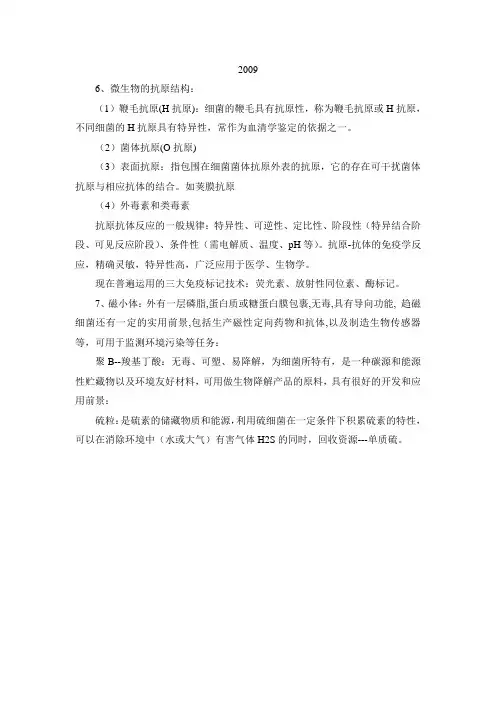
2009
6、微生物的抗原结构:
(1)鞭毛抗原(H抗原):细菌的鞭毛具有抗原性,称为鞭毛抗原或H抗原,不同细菌的H抗原具有特异性,常作为血清学鉴定的依据之一。
(2)菌体抗原(O抗原)
(3)表面抗原:指包围在细菌菌体抗原外表的抗原,它的存在可干扰菌体抗原与相应抗体的结合。
如荚膜抗原
(4)外毒素和类毒素
抗原抗体反应的一般规律:特异性、可逆性、定比性、阶段性(特异结合阶段、可见反应阶段)、条件性(需电解质、温度、pH等)。
抗原-抗体的免疫学反应,精确灵敏,特异性高,广泛应用于医学、生物学。
现在普遍运用的三大免疫标记技术:荧光素、放射性同位素、酶标记。
7、磁小体:外有一层磷脂,蛋白质或糖蛋白膜包裹,无毒,具有导向功能, 趋磁细菌还有一定的实用前景,包括生产磁性定向药物和抗体,以及制造生物传感器等,可用于监测环境污染等任务:
聚B--羧基丁酸:无毒、可塑、易降解,为细菌所特有,是一种碳源和能源性贮藏物以及环境友好材料,可用做生物降解产品的原料,具有很好的开发和应用前景:
硫粒:是硫素的储藏物质和能源,利用硫细菌在一定条件下积累硫素的特性,可以在消除环境中(水或大气)有害气体H2S的同时,回收资源---单质硫。
1995-2007年江南大学发酵微生物考研真题
1995-2007年江南大学发酵微生物考研真题1995年硕士学位研究生入学考试试题第一部分一、填空1、微生物的分类方法有()()()三种,目前常用的是()2、荚膜是指()据其在细胞表面的状况可以分为()()()()四类3、耐高温微生物之所以能在较高的温度下生存和繁殖,主要是因为()4、防止菌种衰退的主要措施有()()()()5、空气中的微生物主要来源于()()()()6、制备固体培养基常用的凝固剂主要有()()()二、判断1、原噬菌体是指蛋白质外壳尚未包装完成的噬菌体()2、营养琼脂培养基可以用于培养E.coli, Lys- Met -,Str-菌株()3、在对数生长期中,细菌的生长速度是不变的()4、微生物在其生长温度范围之外的湿度下即停止生长并快速死亡()5、细菌的抗药性的产生是基因突变的结果()6、为避免细胞对DNA的损伤的修复,经过紫外线诱变的细胞要在红光下做避光培养()7、兼性厌氧微生物在氧化还原电位大于或小于+0.1v的环境中均可以生长,只是获取能量的方式不同()8、构成细胞壁网状骨架结构的主要物质在细菌和放线菌中是肽聚糖,在酵母菌和霉菌中是葡聚糖()三、单选1、用单细胞微生物进行发酵时,应该选用()的种子进行菌种扩培A 对数前期B 对数中期C 对数后期D 稳定期2、能造成碱基烷化的诱变剂是()A NTGB HNO2C 5-BUD ICR-1003、供受体菌细胞间不接触即可进行基因重组的方式为()A 接合B 转导C 转化D 原生质体融合4、察式培养基用于培养()A 细菌B 放线菌C 酵母菌D 霉菌5、对staphylococcus aureus 进行革兰式染色后镜检时发现有少量细胞成红色,其原因是()A 脱色过度B 培养时间过长细胞衰老C 活化不好有死细胞存在D 三种情况都有可能6、由菌株A+B-和A-B+形成的异核体菌落上所长出的分生孢子一般情况下在()培养基上不能萌发A MMB MM+AC MM+BD MM+A+B7、对于Bacillus subtilis而言。
2009年中国科学院研究生院微生物学考研真题(回忆版)(不完整)【圣才出品】
2009年中国科学院研究生院微生物学考研真题(回忆版)(不完整)
一、名词解释
1.富集培养基和选择性培养基
2.底物水平磷酸化和光合磷酸化
3.自生固氮和共生固氮
4.普通转导和局部转导
5.基因组和基因组文库
6.接合子和转化子
7.微生物三命名法和双命名法
8.支原体和衣原体
9.MHC-I和MHC-II
10.病毒结构蛋白和非结构蛋白
二、匹配题
1.给出微生物的名称选出它属于哪一类
2.M13载体、粘粒载体、细菌质粒、细菌人工合成核酸,Ti质粒的作用
三、填空题
略
四、简答题
1.关于培养基配置的原则。
2.关于基因突变的特点。
3.关于三域学说的内容和它的不足。
4.酶的变构调节和化学修饰调节区别?各自有什么用?
5.检测蛋白与染色质DNA作用的方法?举出一种说明原理和步骤。
江南大学微生物2009年考研真题
2009年江南大学微生物学考研试题江南大学微生物学微生物问答1实验室内五种常用的消毒,灭菌,除菌方法2.紫外线对氨基酸缺陷型的诱变过程,氨基酸缺陷型的定义及在工业微生物上的应用3.霉菌,细菌,病毒,酵母菌的繁殖方式4微生物相互之间的作用类型,并举例说明三.问答题(90分)1.简述大肠杆菌,酿酒酵母,红曲霉,噬菌体的繁殖过程,并丛微生物的繁殖方式角度阐述你对微生物多样性的了解(20分)2.简述营养物质进出细胞的方式,并丛运输方向,运输动力,载体,是否耗能,有无竞争性,运输前后是否变化,输送物质类别(举例)等方面比较各种运输方式(20分)3.什么叫基因工程?为什么说基因工程的操作离不开微生物(15分)4.简述斜面培养基的配制步骤?并说明每步的注意事项(15分)5.以赖氨酸高产菌株为出发菌株,筛选菌种的题,记不清了(20分)名词解释19971原生质体2芽孢3菌落4诱导酶5生长因素6回复突变7诱导8拮抗9血清学反应10巴斯德效应19981芽孢2菌落3质粒4回复突变5生长因子6诱导酶7拮抗8巴斯德效应9光复活作用10活性污泥19991原生质体2菌落3质粒4芽孢5诱导酶6生长因子7巴斯德效应8营养缺陷型9 BOD 10血清学反应20001温和性噬菌体2巴斯德效应3 艾姆斯试验(Ames test)4 ELISA 5 PCR20011类毒素2暗修复作用3巴斯德效应4 诱导酶20021转化2 半抗原3活性污泥4回复突变5 PCR填空19971微生物生长的特点是:_____2微生物的学名是由_和_所组成3细菌革兰氏染色的主要原理是_。
影响染色的主要因素是_和_,革兰氏染色后为红色的是_4酵母菌是_,其无性繁殖方式是_和_,有性繁殖是_5霉菌产生的无性孢子有___6噬菌体的特点是___,其生长繁殖过程包括_____五个步骤。
7培养基按用途可分为_____8根据生长和O2的关系,大多数酵母属于_,大多数霉菌属于_9影响微生物生长的延滞期长短的因素有___等10光复活作用是指____四种情况11染色体畸变是指____四种情况12大肠杆菌是指_食品中大肠菌群测定的食品卫生含义是_13影响微生物的抗热性的因素是_____14 BOD是指_15在空气中能较长时间的微生物类群是__特点是_16培养时,培养皿倒置是为了_和_17平板菌落计数法结果表达中常用的“clu”的意思是_19981微生物的特点是_____2微生物的学名有_和_所组成3细菌革兰氏染色的主要原理是_影响染色的主要因素是_ 和_,革兰氏染色后为红色的是_菌4霉菌产生的无性孢子是___5微生物的培养基按用途可分为_____6根据生长和氧气的关系,大多数酵母属于_,大多数霉菌属于_7影响微生物生长的延滞期长短的因素有___等8染色体畸变有____四种情况9影响微生物的抗热性的因素是_____10在空气中能较长时间的微生物类群是__特点是_11培养时,培养皿倒置是为了_和_12平板菌落计数法结果表达中常用的“clu”的意思是_13 BOD是指_20001影响革兰氏染色结果的因素是___,E.coli属于_性菌,染色结果为_色2生长因子是_,主要包括___3影响微生物生长的延滞期的主要因素是___4根据微生物生长和氧气的关系,可分为___三大类型。
2009年微生物
2009年微生物第一篇:2009年微生物微生物检验中级试题 A1题型1.机体抵抗病原微生物的屏障结构包括A、皮肤与粘膜B、血脑屏障C、胎盘屏障D、免疫系统E、A、B和C 答案E2.有关内毒素的描述哪项是错误的A、均由革兰氏阴性菌产生B、其化学成分为脂多糖C、160℃,2~4小时才被破坏D、毒害效应具有组织器官选择性E、毒性作用较弱答案D3.下列描述哪项是错误的A、病原菌致病力的强弱度称为毒力B、毒力主要由侵袭力和毒素所决定C、破伤风毒素属于内毒素D、侵袭力是指病原菌突破宿主机体的防御功能,并能在体内定居、繁殖和扩散的能力E、以上均不是答案C4.下列哪种成分不属于外毒素A、脂多糖B、痉挛毒素C、肉毒毒素D、表皮剥脱毒素E、霍乱肠毒素答案A5.下列哪种成分不属于外毒素A、金黄色葡萄球菌肠毒素B、产毒性大肠杆菌肠毒素C、白喉毒素D、表皮剥脱毒素E、类脂A 答案E6.内毒素的毒性作用包括A、发热反应B、白细胞反应C、内毒素血症与内毒素休克D、以上都是E、A和C 答案D7.慢性志贺菌感染的病程一般在()以上A、两周B、一个月C、两个月D、六周E、七周答案C8.志贺菌随饮食进入体内,导致人体发病,其潜伏期一般为A、一天之内B、1-3天C、5-7天D、7-8天E、8天以后答案B9.下列关于结核分支杆菌描述正确的是A、类脂质为胞壁中含量最多的成分B、产生外毒素C、产生内毒素D、耐药性低E、一般采用革兰氏染色答案A10.我国的卫生标准中,每升饮用水中不得超过()个大肠杆菌A、1B、3C、5D、7E、8答案B11.大肠杆菌指数测定时,37℃培养24小时,能发酵乳糖()为阳性A、产酸B、产酸产气C、产酸不产气D、产气不产酸E、以上都不产生答案B12.下列何种细菌为革兰氏阴性菌A、脑膜炎奈瑟菌B、结核分支杆菌C、铜绿假单细胞D、枯草芽孢杆菌E、白喉棒状杆菌答案C13.下列何种细菌为革兰氏阳性杆菌A、大肠杆菌B、铜绿假单细胞C、产气肠杆菌D、结核分支杆菌E、肺炎克雷白杆菌答案D14.下列何种细菌为革兰氏阴性球菌A、乙型溶血性链球菌B、肺炎链球菌C、铜绿假单细胞D、脑膜炎奈瑟菌E、肺炎克雷白菌答案D15.下列何种细菌革兰氏染色阴性A、乙型溶血性链球菌B、军团菌 C、肺炎链球菌 D、金黄色葡萄球菌 E、结核分支杆菌答案:B16.下列何种微生物培养时会产生β-溶血环现象 A、肺炎链球菌 B、军团菌C、乙型溶血性链球菌D、肺炎支原体E、肺炎衣原体答案:C17.肠炎型沙门氏菌感染的潜伏期一般为 A、6小时以内B、6-24小时C、24-28小时D、48-72小时E、72小时答案:B18.人类感染沙门氏菌,最常见的是A、伤寒和副伤寒B、肠炎型C、败血症型D、慢性携带者E、以上都不是答案:B19.以下细菌感染,可以出现玫瑰疹的是 A、ETEC B、EPECC、志贺菌D、伤寒沙门氏菌E、假结核耶尔森菌答案:D20.以下关于伤寒沙门氏菌感染后,人体免疫情况的描述中,错误的是A、病愈后,有牢固的免疫力B、主要是细胞免疫C、血流中的特异性抗体对胞内菌作有很大D、胃肠炎的恢复与局部生成的分泌型lgA有关E、可形成健康携带者答案:C21.狂犬病毒街毒经过系列传代适应特定宿主后可称之为:A、固定毒B、野毒株或街毒C、病毒原型D、减毒株E、强毒株答案:A22.近年来随着分子病毒学研究的不断深入,相继研究出了多种用基因工程的方法构建的疫苗,这些疫苗不包括下列哪一种A、亚单位疫苗B、基因工程疫苗C、活载体疫苗D、减毒活疫苗E、分子疫苗答案:D23.第二次抗原刺激时,由于下列哪一个原因使得lgG量显著增高A、自身保护免疫B、强化免疫C、免疫回忆D、免疫持久性E、免疫应答答案:C24.以下哪种说法是错误的A、细菌分离培养法包括平板划线法B、细菌分离培养法包括倾注平板法C、细菌分离培养法包括液体培养基接种法D、纯种细菌接种法包括斜面培养基接种法E、纯种细菌接种法包括穿刺接种法答案:C25.细菌诊断中标本采集和运送的原则包括A、标本必须新鲜,采集后尽快送检B、在送检过程中,对脑膜炎球菌标本要进行保温C、在检验容器上要贴好标签D、尽可能采集病变明显部位的材料E、以上都是答案:E26.下列哪项属于内毒素的特征A、均由革兰氏阴性菌产生B、为蛋白质C、60-80℃,30分钟被破坏D、毒害效应具有组织器官选择性E、毒性作用强答案:A 27.下列哪项不属于外毒素的特征A、来源于革兰氏阳性菌和部分革兰氏阴性菌B、甲醛液处理不形成类毒素C、60-80℃,30分钟被破坏D、害效应具有组织器官选择性E、毒性作用强答案:B28.恙虫病在国外最早首先描述本病A、于1610年B、于1710年C、于1810年D、于1910年E、于1920年答案:D29.恙虫病在国外最早首先描述本病A、美国人B、加拿大C、法国人D、日本人E、英国答案;D30.我国首次分离出恙虫病立克次体是A、在上海B、在北京C、在天津D、在广州E、在重庆答案:D31.我国首次分离出恙虫病立克次体是A、1928年B、1938年C、1948年D、1958年E、1968年答案:C32.钮扣热主要分布在A、美洲B、亚洲C、非洲D、欧洲E、澳洲答案:D33.在对微生物进行灭菌时,根据不同的微生物种类采用不同的灭菌方法和时间是很重要的,在以下哪种说法中,哪项是错误A、高压蒸汽灭菌法是一种最有效的灭菌方法B、煮沸法5分钟可杀灭细菌的芽胞C、在煮沸法灭菌时,水中加1-2%的碳酸氢钠可提高沸点D、在煮沸法灭菌时,水中加入-2%的碳酸氢钠可防止金属器皿生锈E、间歇灭菌法适合于不耐100℃物质的消毒答案:B34.加利福尼亚鼠型斑疹伤寒主要分布在A、美洲B、亚洲C、非洲D、欧洲E、澳洲答案:A35.传染性单核细胞增多症是由下列哪一种立克次体引起的A、查菲埃立克体B、杆菌样巴立克体C、腺热埃立克体D、汉赛巴通体E、人粒细胞埃立克体答案:C36.某实验室在进行肠道菌鉴别诊断时,进行了大量生化检定,有关VP试验,哪种说法是错误A、主要鉴别大肠杆菌和产气杆菌B、VP试验阳性时,产生黄色化合物C、大肠杆菌VP试验阴性D、产气杆菌VP试验阳性E、大肠杆菌和产气杆菌均能分解葡萄糖产生丙酮酸答案:B37.有关细菌学检验的描述哪项是错误的A、原则上所有标本均应作病原分离培养B、需3-4周才长菌落C、结核杆菌需4-8周才长成菌落D、分离培养的阳性率一般比直接涂片镜检的阳性率为低E、布氏杆菌初次培养时需5-10%的CO2答案:D38.以下哪种说法是错误的A、霍乱红试验阳性为霍乱弧菌所特有的反应B、尿素试验阳性时呈红色C、变形杆菌等尿素酶试验阳性D、霍乱弧菌能液化明胶E、沙门氏菌硫化氢试验为阳性答案:A39.以下哪种说法是错误的A、硫化氢试验常用于区别肠道杆菌的种类B、志贺氏菌硫化氢试验阴性C、产气杆菌硫化氢试验阴性D、大肠杆菌硫化氢试验阳性E、沙门氏菌硫化氢试验阳性答案:D40.以下哪种说法是错误的A、在甲基红试验中,呈现红色为阳性B、甲基红试验阳性时,培养物酸碱度在pH4.5或更低C、大肠杆菌的枸橼酸盐利用试验为阳性D、产气杆菌VP试验阳性E、枸橼酸利用试验阳性反应时呈深蓝色答案:C41.以下哪种说法是错误的A、在甲基红试验中,呈现红色为阳性B、甲基红试验阳性时,培养物的酸碱度在pH4.5或更低C、大肠杆菌甲基红试验阴性D、产气杆菌VP试验阳性E、大肠杆菌和产气杆菌均能分解葡萄糖产生丙酮酸答案:C42.哪种说法是不正确的A、微生物数量越大,消毒越困难B、一般是温度越高,消毒灭菌效果越好C、洗必泰在碱性时杀菌作有减弱D、硫代硫酸钠可中和氯或氯化物E、以上均是答案:C43.哪种消毒剂的效果受蛋白质等有机物的影响较小A、季铵盐类B、乙醇C、次氯酸盐D、戊二醛E、以上均是答案:DA2题型44.某乡镇卫生院大夫,在采集到可疑流脑病人细菌培养用标本后,因缺少培养条件,需送上级医院进行进一步病原培养,所遵循的如下标本采集和运送原则中哪项是错误的A、注意无菌操作。
- 1、下载文档前请自行甄别文档内容的完整性,平台不提供额外的编辑、内容补充、找答案等附加服务。
- 2、"仅部分预览"的文档,不可在线预览部分如存在完整性等问题,可反馈申请退款(可完整预览的文档不适用该条件!)。
- 3、如文档侵犯您的权益,请联系客服反馈,我们会尽快为您处理(人工客服工作时间:9:00-18:30)。
ቤተ መጻሕፍቲ ባይዱ
圣才电子书 十万种考研考证电子书、题库视频学习平台
2009 年江南大学 605 微生物学(A)考研真题
1/2
圣才电子书 十万种考研考证电子书、题库视频学习平台
考试科目:605 微生物学 请将题号和答案写在答题纸上,直接写在试卷上无效 一、名词解释(3×10=30) 1.细菌间体 2.无氧呼吸 3.反馈抑制 4.无义突变 5.PCR 6.鉴别培养基 7.Prion 8.BOD5 9.营养缺陷型 10.Variable but Noncultural Microbe 二、问答题(20×6=120) 1.试述实验室常用的五种灭菌消毒方法的原理、优缺点、适用对象及注意事项。 2.试述紫外线对氨基酸缺陷型的诱变过程,氨基酸缺陷型的定义及在工业微生物上的应用。 3.试比较霉菌、病毒、细菌、酵母菌的繁殖方式。 4.试讨论微生物之间的作用类型,并举例说明。 5.何为微生物的二次生长现象?试用乳糖操纵子模型说明。 6.何为微生物的生长曲线?试说明其规律。
